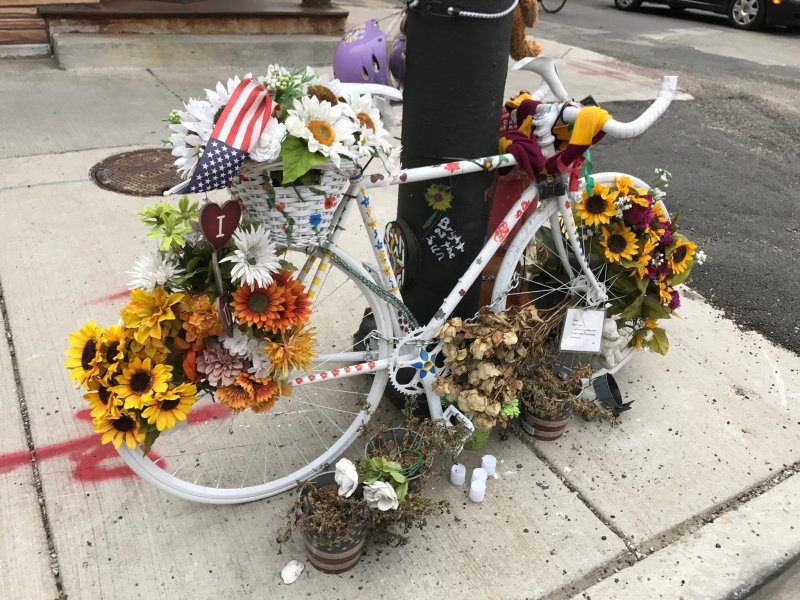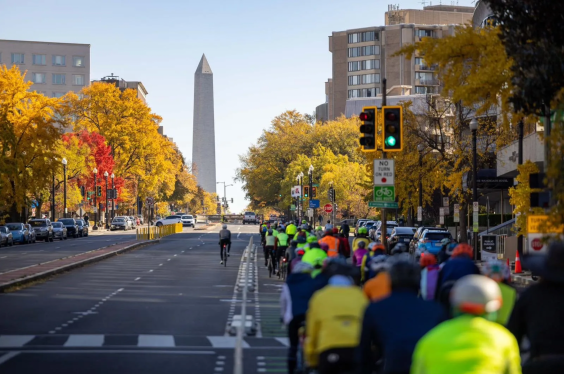[The Chicago Reader publishes a weekly transportation column written by Streetsblog Chicago editor John Greenfield. We syndicate a portion of the column on Streetsblog after it comes out online.]
A memorial all too familiar to cyclists sits at the southeast corner of Addison and Damen in Roscoe Village: a white-painted "ghost bike" covered with silk flowers and surrounded by plants and candles. At the base is a plaque that reads "Anastatia Kondrasheva: she will shine forever." Attached to the cycle's head tube by a maroon-and-gold Harry Potter-style scarf, there's a snapshot of the young crash victim, bespectacled and smiling. A laminated spoke card reads "Nastya, always an angel . . . and now you have wings to prove it."
Last September the 23-year-old health coach was biking north on Damen to work when a flatbed truck driver failed to yield while making a right turn onto Addison and struck her. She fell under the massive vehicle and was fatally crushed by the wheels.
Tragically, this type of fatal crash was unusually prevalent last year. Virginia Murray, 25, and Lisa Kuivinen, 20, were also struck and killed on bikes by right-turning flatbed truck drivers on the near northwest side last summer. These three cases represented half of all 2016 Chicago bike fatalities. A fourth cyclist, 18-year-old Chuyuan Qiu, died four days before Kondrasheva, after the driver of a concrete mixer struck her in Evanston and she went under the wheels.
In the wake of these four fatalities, as well as a fifth truck-bike crash on the near west side that seriously injured 26-year-old Danielle Palagi, the Reader called on City Hall to follow the leads of New York and Boston by requiring side guards for municipal trucks and other large vehicles operating within the city. These devices—already widespread in Europe, Japan, Brazil, and other countries—prevent pedestrians and cyclists who are struck by trucks from falling underneath the vehicle and being crushed by the rear wheels. In the U.K. alone, the fatality rate for turning-truck crashes dropped by 20 percent for pedestrians and 61 percent for cyclists after 1986, when it began requiring the equipment on most new trucks.
At the same time we put out this call for change, the Active Transportation Alliance was working to make it happen. The advocacy group prepared recommendations for Chicago's Vision Zero plan to eliminate serious crashes and fatalities by 2026, which included a proposal for an ordinance requiring truck side guards and/or convex mirrors that help reduce blind spots. The organization also launched an online petition urging the city to take action to reduce the dangers posed by large vehicles on city streets, which also listed strengthening commercial driver licensing rules and limiting large vehicle traffic during rush hours as possible solutions. The petition garnered 850 signatures.
The advocacy push paid off. When the Vision Zero Chicago Action Plan was released in June, it included a recommendation for an ordinance requiring side guards and convex mirrors on large city fleet trucks and contractor vehicles. The plan noted that while large vehicles travel only 8 percent of all the miles driven by vehicles in Chicago, they're involved in 12 percent of fatal bike and pedestrian crashes. Mayor Rahm Emanuel and the Chicago Department of Transportation introduced the ordinance to the City Council later that month.
At a Budget Committee hearing on the ordinance as well as a plan to earmark $5 million for retrofitting 1,700 city vehicles, CDOT commissioner Rebekah Scheinfeld told aldermen that side guards might have made a difference in a fatal 2015 truck crash. As 30-year-old Mexican immigrant Elizabeth Peralta-Luna and her children Elizabeth, nine, and Dylan, four, were walking in a crosswalk at 43rd and Ashland, a left-turning truck driver struck them. "The first point of impact was the rear wheels of the truck. That means that Ms. Peralta-Luna and her children were caught up underneath the truck and perished," Scheinfeld said, according to a Sun-Times report.
The City Council passed the ordinance on July 26. "Chicago is using a data-driven approach to improve traffic safety, and the data shows we can save lives and prevent serious injuries by installing this type of safety equipment," Emanuel stated at the time.
The new ordinance requires that any business with a city contract worth $2 million or more install side guards and convex mirrors on all trucks used to fulfill the contract that weigh 10,000 pounds or more. As my Streetsblog Chicago colleague Steven Vance has noted, the legislation isn't perfect, since it doesn't cover all large vehicles operating in Chicago, it will take years to phase in the safety gear, and there are loopholes contractors can use to avoid compliance.
The law provides nearly a year's notice before the first stage of compliance kicks in, requiring contractors to outfit 25 percent of the 10,000-pound-plus vehicles to be used for work performed between June 2018 and July 2019. Each year after that, another quarter of the vehicles to which the ordinance applies must be outfitted, so that the full fleet used for a contract must have the gear by August 2021, four years from now. (The city plans to upgrade its own fleet by 2026, the year by which the city also hopes to eliminate all crash fatalities.)
However, if they can't meet the deadlines, contractors can apply for six-month extensions on installing side guards and mirrors. On top of that, businesses can ask the city's procurement department for one-year waivers on the rules if they can demonstrate "undue financial hardship" in complying with the ordinance. The department can grant the same outfit multiple waivers, so it might be possible for a contractor to put off installing the gear for years.
But at last week's Mayor's Pedestrian Advisory Council meeting, CDOT's Vision Zero manager Rosanne Ferruggia suggested it's unlikely that many contractors will try to weasel out of installing this potentially life-saving equipment. The city estimates that side guards cost $3,100 per vehicle to install, and a pair of convex mirrors costs $400. "Usually one of these trucks is $150,000 or more," she noted. "So in the scope of what the cost of the vehicle is, it's fairly inexpensive."
"We're really happy that we've had our first Vision Zero policy change come through," Ferrugia added. "This is going to help make the streets safer for all."
Four promising young lives were cut short by truck-bike crashes in the region last year. Hopefully the victims' loved ones can take some solace in knowing that these cases helped bring about legislation that will help prevent similar tragedies.






